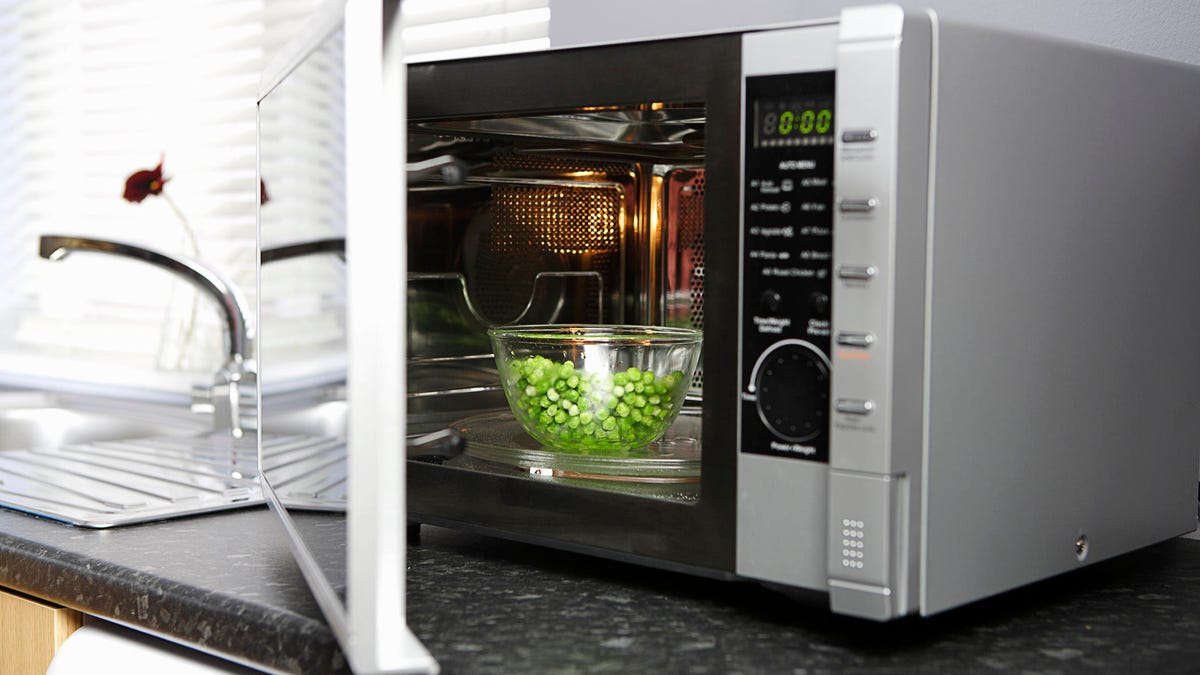Can You Survive in a Microwave

No, you cannot survive in a microwave due to the extreme heat and radiation it emits. Microwaves are commonly used in kitchens for quick cooking and heating purposes.
However, their functionality is strictly limited to heating food and beverages. It is important to note that microwaves are not designed for human habitation or safety. They emit electromagnetic radiation and rely on the absorption of microwave energy by water molecules in order to heat food.
This is achieved through a process called dielectric heating. While microwaves have safety mechanisms such as a door seal and a protective mesh, any attempt to stay inside a microwave can be extremely dangerous and potentially lethal. The heat generated and the direct exposure to microwave radiation can cause severe burns and harm to internal organs. Therefore, it is crucial to use microwaves for their intended purpose and not as a living space.
The Science Behind Microwaves
Microwaves at high power can be extremely dangerous. Microwaving oneself can cause severe burns, internal organ damage, and even death due to the electromagnetic waves produced. Surviving in a microwave is not possible due to the intense heat generated.
What Are Microwaves?
Microwaves are a type of electromagnetic radiation that falls within the spectrum between radio waves and infrared radiation. Unlike radio waves, microwaves have higher frequencies and shorter wavelengths. These waves are used in microwave ovens to cook and heat food.
Here are some key points about microwaves:
- Microwaves are a form of non-ionizing radiation, which means they don’t have enough energy to cause damage to the DNA in our cells.
- They are produced by a device called a magnetron, which converts electrical energy into microwaves by using a magnetic field and an electron beam.
- Microwaves have the ability to penetrate food and cause the water molecules within it to vibrate rapidly. This vibration generates heat, cooking the food from the inside out.
- In addition to cooking, microwaves are also used for communication purposes, such as in radar systems and satellite communications.
How Do Microwaves Work?
Microwaves work through a process called dielectric heating, which is the process of heating an object by moving its molecules back and forth. Here’s how microwaves work in more detail:
- Microwaves emit electromagnetic waves that are absorbed by the water molecules present in food.
- When microwaves enter the microwave oven, they bounce off the reflective walls and are absorbed by the food.
- Once absorbed, the microwaves cause the water molecules in the food to vibrate rapidly. This vibration generates heat throughout the food, cooking it evenly.
- The microwaves are not absorbed by plastic, glass, or ceramic materials, which is why microwave-safe containers are made from these materials.
- It is important not to put metal objects inside a microwave as they can reflect the microwaves, causing sparks and potential damage to the oven.
The Effects Of Microwaves On Food
Microwaves have several effects on food due to the way they cook. Here are some important points to note about the effects of microwaves on food:
- Microwaving food generally preserves more nutrients compared to other cooking methods like boiling or frying. The rapid cooking time and minimal water usage help to retain vitamins and minerals.
- Microwaves can cause uneven heating in food, resulting in hot and cold spots. It is essential to stir or rotate the food during the cooking process to ensure even distribution of heat.
- Certain foods with a high water content, such as soups or vegetables, tend to cook well in microwaves. However, foods with thicker or denser textures may take longer to cook evenly.
- Microwaves do not brown or crisp food like traditional cooking methods do. To achieve a crispy texture, it is necessary to use additional cooking techniques such as broiling or pan-frying after microwaving.
- It’s important to follow the instructions on food packaging when using a microwave, as some foods require specific cooking times and power levels for optimal results.
Microwaves are a type of electromagnetic radiation used in microwave ovens to cook and heat food. They work by causing water molecules in the food to vibrate rapidly, generating heat. Microwaving food can preserve nutrients but may result in uneven heating and the need for additional cooking techniques for browning or crisping.
Safety Measures For Microwave Usage
Ensure your safety when using a microwave by following these essential guidelines. Discover how to avoid dangerous situations and protect yourself from harm while operating this common kitchen appliance.
Understanding Microwave Safety Guidelines
Microwaves have become an essential kitchen appliance in many households, offering convenience and speed when it comes to cooking or reheating food. However, it is crucial to follow proper safety measures to avoid accidents and mishaps. Understanding microwave safety guidelines can ensure safer usage.
Here are some key points to keep in mind:
- Placement: Position your microwave in a well-ventilated area with enough clearance on all sides to prevent overheating and potential fire hazards. Avoid placing it near flammable materials.
- Suitable Cookware: Only use microwave-safe cookware that is specifically labeled as such. Avoid using metal containers or aluminum foil as they can cause sparking and damage to the microwave.
- Covering Food: Always cover your food with a microwave-safe lid or microwave-safe plastic wrap to prevent splattering and maintain even heating.
- Stirring and Testing: Stir your food and test its temperature before consuming, especially when heating liquids. This helps distribute heat evenly and prevents accidental burns.
- Timer and Power Levels: Use the microwave’s built-in timer feature to avoid overcooking or overheating your food. Adjusting power levels can also help ensure that your food is cooked properly.
- Safety Lock: If your microwave has a safety lock feature, make sure to activate it when not in use to prevent accidental start-up or unauthorized usage, particularly if you have children in the house.
Common Mistakes To Avoid When Using Microwaves
While microwaves are designed to be user-friendly, there are some common mistakes that people often make. Being aware of these mistakes can help you avoid potential hazards and maximize your microwave’s efficiency. Here are a few common mistakes to steer clear of:
- Using Non-Microwave Safe Containers: Using inappropriate containers, such as plastic containers not labeled as microwave-safe or glassware with metallic accents, can lead to dangerous situations. Always check for microwave-safe labels before using any container.
- Overheating Liquids: Liquids, particularly water, can become superheated in the microwave, meaning they can reach boiling temperature without showing visible signs. To avoid unexpected eruptions, place a chopstick or microwave-safe object in the liquid to facilitate even heating.
- Neglecting Cleaning and Maintenance: Regularly cleaning your microwave is essential to remove any food splatters or build-up, as they can cause unpleasant odors and potential fire hazards. Also, ensure that the microwave’s door seals properly and that vents are free from obstructions to avoid overheating.
- Ignoring Manufacturer’s Instructions: Each microwave model is different, so it is crucial to read and follow the manufacturer’s instructions regarding usage, power levels, and cooking times. Ignoring these instructions can lead to undercooked or overheated food, or even damage to the microwave.
Potential Dangers Of Mishandling A Microwave
While microwaves are generally safe to use when proper guidelines are followed, mishandling can result in potential dangers. Understanding these dangers can help you take precautions and ensure your safety. Here are a few potential dangers to be aware of:
- Burns and Scalds: Microwaved food and liquids can become extremely hot. Careless removal or handling of hot containers can lead to burns and scalds. Always use oven mitts or appropriate heat-resistant gloves when taking out hot dishes.
- Electric Shock: Microwaves use high voltage and can pose a risk of electric shock if handled improperly. Avoid touching the internal components or attempting to repair the microwave yourself. Consult a professional for any repairs.
- Fire and Smoke: Overheating food or using flammable materials in the microwave can result in fires or smoke. Always monitor your food while it is being heated and never leave the microwave unattended.
- Exposure to Microwaves: Extended exposure to microwaves can be harmful. Avoid standing directly in front of a running microwave and maintain a safe distance to minimize potential exposure.
Following these safety measures and being cautious when using a microwave can help prevent accidents and ensure a safer cooking and reheating experience. Stay informed and prioritize your safety while enjoying the convenient benefits of microwave technology.
Debunking Myths And Misconceptions
Microwaves are a kitchen staple, but can they actually be deadly? Let’s debunk the myth that you can survive being inside a microwave. The truth is, microwaves emit harmful radiation that can cause severe burns and even death. So, it’s best to keep your body out of the microwave and stick to using it for cooking instead.
Microwaves have become an essential appliance in most modern kitchens. However, there are numerous myths and misconceptions that surround their usage and safety. In this section, we will explore and debunk some of the most common myths associated with microwave ovens.
Myth 1: Microwaves Can Cook You From The Inside
- Microwaves use a form of electromagnetic radiation to heat food, but it is non-ionizing radiation, meaning it lacks sufficient energy to alter the atomic or molecular structure of living cells.
- The microwaves generated by these ovens are designed to be contained within the appliance, and the metal mesh screen on the door prevents radiation leakage.
- As long as the microwave is properly maintained and in good working condition, there is no risk of being cooked or harmed from the inside.
Myth 2: Microwaving Food Destroys Its Nutrients
- Like any cooking method, microwaving can cause some nutrient loss, but it is generally less than other conventional cooking methods.
- The shorter cooking time and lower temperatures often used in microwaving help to preserve nutrients, especially heat-sensitive vitamins.
- Some studies have shown that microwaving can retain more nutrients compared to boiling or frying, as it requires minimal water and shorter cooking durations.
Myth 3: Microwaves Cause Radiation Exposure
- Microwave ovens generate electromagnetic radiation, but the levels they emit are well below the safety limits regulated by organizations such as the Food and Drug Administration (FDA).
- These appliances are designed with safety features to prevent radiation leakage, and regular testing and certification ensure they meet the necessary safety standards.
- As long as you are using a properly functioning microwave and following the manufacturer’s instructions, there is no significant risk of radiation exposure.
Microwave ovens have become a convenient and time-saving tool in our daily lives. By understanding and dispelling these myths and misconceptions, you can confidently utilize your microwave oven without any undue health concerns. Remember to always follow the manufacturer’s instructions and maintain your appliance to ensure safe and efficient operation.
The Human Body And Microwaves
Microwaves can be deadly to the human body. The intense heat generated by a microwave can lead to severe burns, internal injuries, and even death. It is impossible to survive being inside a microwave due to the high levels of radiation.
What Happens When The Human Body Is Exposed To Microwaves?
Microwaves have become a staple in many kitchens for their convenience and speed in heating food. However, there has been ongoing speculation about the effects of microwaves on the human body. In this section, we will explore how microwaves interact with living tissues, examine research on the effects of microwaves on human health, and provide recommended precautions for individuals with implants.
How Microwaves Interact With Living Tissues:
- Microwaves work by emitting electromagnetic waves that cause water molecules in food to vibrate, producing heat that cooks the food.
- When exposed to microwaves, living tissues can also absorb these electromagnetic waves, leading to a rise in temperature within the body.
- The extent of tissue heating depends on factors such as the duration of exposure, the power of the microwave, and the proximity of the individual to the microwave source.
Research On The Effects Of Microwaves On Human Health:
- Numerous studies have been conducted to investigate the potential health effects of microwave exposure.
- Some research suggests that prolonged or excessive microwave exposure may lead to thermal burns, especially in areas where blood flow is limited, such as the eyes or extremities.
- However, these thermal effects are generally unlikely to occur during normal microwave usage in everyday scenarios.
- Studies on the non-thermal effects of microwaves, such as potential DNA damage or changes in cell metabolism, have produced mixed results.
- Nonetheless, the overall consensus among experts is that microwaves pose minimal risk to human health when used properly.
Recommended Precautions For Individuals With Implants:
- Individuals with medical implants, such as pacemakers or cochlear implants, are often concerned about the potential interference of microwaves.
- However, most modern medical implants are designed to be shielded from external electromagnetic interference, including microwaves.
- To ensure safety, individuals should consult with their healthcare provider or the manufacturer of their implant for specific guidelines regarding microwave usage.
- It is important to note that the majority of medical implants undergo rigorous testing to withstand environmental factors, including microwave radiation.
Microwaves interact with living tissues by causing water molecules to vibrate and generate heat. While research has explored the effects of microwave exposure on human health, the risks are generally minimal when used within normal parameters. Individuals with implants should consult with their healthcare provider for specific guidelines.
As always, using microwaves responsibly and following recommended precautions ensures a safe cooking experience for everyone.
Surviving In A Microwave: Fact Or Fiction?
Surviving in a microwave may sound like something out of a sci-fi movie, but the truth is, it’s purely fiction. Microwaves are designed to heat food, not humans, and entering one would result in serious burns and injuries. It’s important to separate fact from fiction when it comes to microwave safety.
Microwaves have become an essential kitchen appliance in most households, enabling us to quickly warm up our meals or even cook them from scratch. We’ve all heard rumors and tales about people attempting to survive in a microwave, but is there any truth to these stories?
In this blog post, we will delve into the world of microwaves and debunk some myths surrounding their potential for human survival.
Experimental Studies On Human Interaction With Microwaves
- Researchers have conducted numerous experiments to determine the effects of microwaves on human beings.
- These studies have shown that microwave radiation primarily affects the water molecules within our food, causing them to vibrate rapidly and generate heat.
- However, the human body is composed mainly of water, making it vulnerable to the heating effects of microwaves.
- Researchers have found that even brief exposure to microwave radiation can cause severe burns and tissue damage.
The Truth Behind Viral Microwaving Challenges
- In recent years, viral challenges have emerged on social media platforms, encouraging individuals to step inside a microwave and see if they can survive the experience.
- These challenges often claim that by using various protective measures or techniques, individuals can withstand the microwave’s heat.
- However, attempting such challenges is extremely dangerous and can have life-threatening consequences.
- The intense heat generated by microwaves can quickly overwhelm the body’s cooling mechanisms, leading to heatstroke or even death.
- It is vital to remember that microwaves are designed to heat food efficiently, not provide a safe space for human survival.
Why Surviving In A Microwave Is Physically Impossible
- Microwaves operate at a frequency of 2.45 gigahertz, which corresponds to the natural resonant frequency of water molecules.
- When exposed to these microwaves, water molecules rapidly absorb the radiation, resulting in heating and molecular excitation.
- The human body’s inability to withstand prolonged exposure to high temperatures makes surviving in a microwave physically impossible.
- Additionally, microwaves heat food unevenly, resulting in hot and cold spots. This uneven heating would make it impossible for someone to find a safe spot within the microwave cavity.
Surviving in a microwave is not only a fictional concept but also an incredibly dangerous one. While microwaves have revolutionized the way we cook and heat our food, they have no place as a habitat for the human body. Experimental studies clearly demonstrate the harm that microwave radiation can inflict on our bodies, making it crucial to never attempt any sort of survival challenge involving these kitchen appliances.
Remember, the next time you use your microwave, it’s best to stick to heating up a delicious meal rather than trying to survive an experiment that could have dire consequences.

Credit: www.cnet.com
Frequently Asked Questions Of Can You Survive In A Microwave
Can You Survive In A Microwave?
No, it is not safe for humans to be inside a microwave. Microwaves emit high-frequency electromagnetic waves that can heat up organic matter, such as your body, causing burns, tissue damage, and even death. Always use microwaves for their intended purposes, such as heating food, and never attempt to climb into one.
Conclusion
Overall, while the idea of surviving in a microwave may seem intriguing, it is crucial to understand that microwaves are not designed for human habitation. The intense heat and radiation generated by microwaves can cause severe burns and other life-threatening injuries.
Beyond the physical dangers, the lack of oxygen and restricted space within a microwave would make it nearly impossible for a person to survive for any prolonged period. It is essential to prioritize safety and use microwaves solely for their intended purpose – heating or cooking food.
Remember to follow the manufacturer’s instructions, ensure the appliance is in good working condition, and never attempt to use a microwave for any other purpose than what it was designed for. By doing so, you can enjoy the convenience and efficiency that microwaves offer, while also keeping yourself and others safe from harm.










